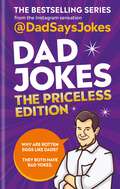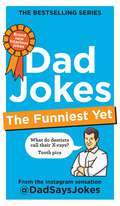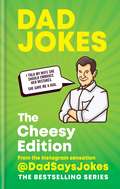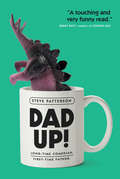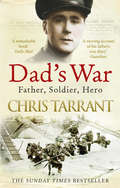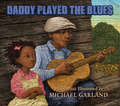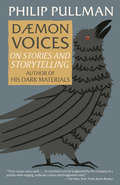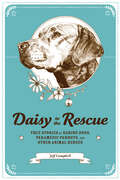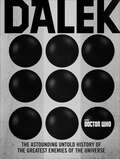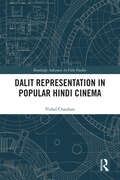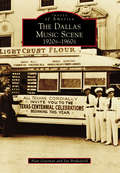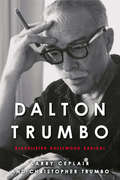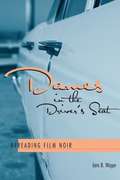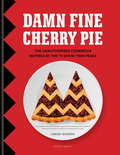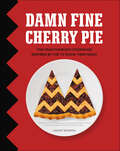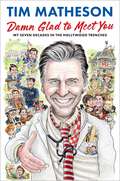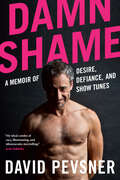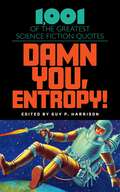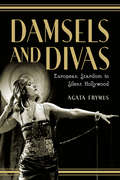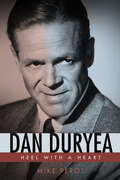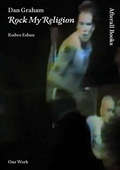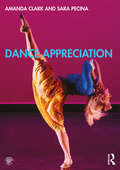- Table View
- List View
Dad Jokes: The Priceless Edition (Dad Jokes #5)
by Dad Says JokesTHE NEW COLLECTION FROM THE SUNDAY TIMES BESTSELLERS @DADSAYSJOKESQ: What do cars spread on their toast?A: Traffic jam.The hit Instagram page @DadSaysJokes returns with an all-new batch of hilarious dad jokes to share with friends and family. Back by popular demand, with hundreds of gags for every occasion, Dad Jokes: The Priceless Edition is the perfect gift for Father's Day, birthdays, Christmastime and beyond.@DadSaysJokes is a community-run Dad jokes network on Instagram, Facebook and Twitter, with over 5 million followers, inspired by the daily jokes of author Kit Chilvers' dad, Andrew. Every day, followers submit their jokes and the team picks their favourites - or Dad just drops in his own zinger! Kit, a young social networking influencer, started his career at the tender age of 14 when he created his original platform, Football.Newz. He has since added another fourteen platforms, including @PubityPets and monster meme Instagram page @Pubity with its 31 million followers. This is his fifth book.
Dad Jokes: The newest collection from the Instagram sensation @DadSaysJokes (Dad Jokes #7)
by Dad Says JokesThe must-have joke collection from the Instagram sensation @DadSaysJokesQ: How can you tell a pig is hot? A: It's bacon. The iconic Instagram page @DadSaysJokes returns with a fresh batch of dad jokes to share with your nearest and dearest. Packed with jokes so bad that they're good, Dad Jokes: The Funniest Yet is the perfect gift for every occasion. @DadSaysJokes is a community-run Dad jokes network on Instagram, Facebook and Twitter, with more than 8 million followers, inspired by the daily jokes of author Kit Chilvers' dad, Andrew. Every day, followers submit their jokes and the team picks their favourites - or Dad just drops in his own zinger! Kit, a young social networking influencer, started his career at the tender age of 14 when he created his original platform, Football.Newz. He has since added another fourteen platforms, including @PubityPets and monster meme Instagram page @Pubity with over 40 million followers. This is his seventh book.
Dad Jokes: The newest collection from the Instagram sensation @DadSaysJokes (Dad Jokes #7)
by Dad Says JokesThe must-have joke collection from the Instagram sensation @DadSaysJokesQ: How can you tell a pig is hot? A: It's bacon. The iconic Instagram page @DadSaysJokes returns with a fresh batch of dad jokes to share with your nearest and dearest. Packed with jokes so bad that they're good, Dad Jokes: The Funniest Yet is the perfect gift for every occasion. @DadSaysJokes is a community-run Dad jokes network on Instagram, Facebook and Twitter, with more than 8 million followers, inspired by the daily jokes of author Kit Chilvers' dad, Andrew. Every day, followers submit their jokes and the team picks their favourites - or Dad just drops in his own zinger! Kit, a young social networking influencer, started his career at the tender age of 14 when he created his original platform, Football.Newz. He has since added another fourteen platforms, including @PubityPets and monster meme Instagram page @Pubity with over 40 million followers. This is his seventh book.
Dad Jokes: The perfect gift from the Instagram sensation @DadSaysJokes
by Dad Says JokesTHE NEW BOOK IN THE BESTSELLING SERIESThe most followed dad jokes page on Instagram, @DadSaysJokes, returns with another collection of hilariously cringe-inducing gags for you to share with friends and family.@DadSaysJokes is a community-run Dad jokes network on Instagram, Facebook and Twitter, with over 3 million followers, inspired by the daily jokes of author Kit Chilvers' dad, Andrew. Every day, followers submit their jokes and the team picks their favourites - or Dad just drops in his own zinger! Kit, a young social networking influencer, started his career at the tender age of 14 when he created his original platform, Football.Newz. He has since added another nine platforms, including @PubityPets and monster meme page @Pubity with its 25 million followers. This is his third book.I TOLD MY WIFE SHE SHOULD EMBRACE HER MISTAKES.SHE GAVE ME A HUG.
Dad Jokes: The perfect gift from the Instagram sensation @DadSaysJokes
by Dad Says JokesTHE NEW BOOK IN THE BESTSELLING SERIESThe most followed dad jokes page on Instagram, @DadSaysJokes, returns with another collection of hilariously cringe-inducing gags for you to share with friends and family.@DadSaysJokes is a community-run Dad jokes network on Instagram, Facebook and Twitter, with over 3 million followers, inspired by the daily jokes of author Kit Chilvers' dad, Andrew. Every day, followers submit their jokes and the team picks their favourites - or Dad just drops in his own zinger! Kit, a young social networking influencer, started his career at the tender age of 14 when he created his original platform, Football.Newz. He has since added another nine platforms, including @PubityPets and monster meme page @Pubity with its 25 million followers. This is his third book.I TOLD MY WIFE SHE SHOULD EMBRACE HER MISTAKES.SHE GAVE ME A HUG.
Dad Up!: Long-Time Comedian. First-Time Father.
by Steve PattersonFrom one of the country's most beloved comedians and host of CBC Radio's incredibly popular program The Debaters comes a funny, poignant, and at times unexpectedly wise look at what it means to be a dad in this day and age.Steve Patterson has been thinking about dad-dom for quite a while. In Dad Up! he gives his all to be the best father possible to two young girls while imparting his hard-won wisdom and insights to readers everywhere.The youngest of five boys growing up in an Irish Catholic household, Patterson mines his childhood for any sage advice he might have picked up from his own dad. He talks with candour about the difficulty he and his wife, Nancy, had conceiving, finding humour in their experiences with the fertility clinic's automated phone calls (which Patterson calls "RoboPimp") informing them when Nancy was ovulating. He chronicles the disappointment of failing to get pregnant, only to have the miracle conception take place in Regina during Grey Cup Week, under the guiding spirit of the Saskatchewan Roughriders and comedian Brent Butt (don't ask).From that point on, Steve Patterson assumes full dad-mode, riffing on the biohazard that is changing a diaper, the absolute futility of stuffed animals, becoming a public breastfeeding warrior in the most unexpected of places, and how growing up a little boy in no way prepares you to being a father to little girls.Most importantly, Dad Up! charts the awesome experience of watching tiny infants that you somehow had a hand in creating evolve into confident and crafty little people, and the lessons that they teach along the way.
Dad's War
by Chris TarrantThe Sunday Times Top Ten BestsellerChris Tarrant and his father Basil were very close, they played sport together, watched sport together and shared the same sense of humour. Chris loved and admired his father but it was only after his death he realised that he hardly knew him at all … Basil Avery Tarrant grew up in 1920s Reading, where the smell of beer and biscuits from the local factories filled the air. He worked as an administrator in a local factory and spent his Saturday nights down at the music halls. But what happened to Basil during the war, and how he came to be awarded the Military Cross, remained a mystery to Chris and his family for nearly sixty years. In this emotional journey, Chris discovers that Basil was involved in some of WWII’s most significant campaigns, including the Dunkirk evacuation and the D-Day landings, and also took part in some of the most brutal, close-range fighting in Cleve. Dad's War is a profoundly moving and heartfelt tribute to a much-loved father, but it’s also a sincere and humble commemoration of the bravery and sacrifice of the soldiers of WWII.
Daddy Played the Blues
by Michael Garland*Notable Social Studies Trade Books Selection for Young People 2018* “I was six years old the day we left the farm in Mississippi,” remembers Cassie in this richly textured picture book. “Between the boll weevils, the floods, and the landlord, there was no way a family could scratch out a living there anymore.” Packing themselves into an old jalopy—with Daddy, Uncle Vern, and Mama in the front seat and Cassie and her two brothers in the back—they joined the Great Migration from the impoverished Deep South to Chicago, where there was work to be had in the stockyards. Across the kids’ laps lay Daddy’s prized possession, a six-string guitar. Daddy worked hard to put food on the table, but what he really loved was playing the blues. This evocative tale of the African-American odyssey in search of a better life is also a homage to the uniquely American music that developed from African music and American spirituals, work songs, and folk ballads. In the book’s backmatter, Garland relates how he first heard and fell in love with blues music, beginning a lifelong fandom. Portraits and thumbnail biographies of great blues musicians and landmark songs complete this tribute to the great American music and the yearnings that produced it. Fountas & Pinnell Level S
Daemon Voices: On Stories and Storytelling
by Philip PullmanFrom the internationally best-selling author of the His Dark Materials trilogy, a spellbinding journey into the secrets of his art--the narratives that have shaped his vision, his experience of writing, and the keys to mastering the art of storytelling.One of the most highly acclaimed and best-selling authors of our time now gives us a book that charts the history of his own enchantment with story--from his own books to those of Blake, Milton, Dickens, and the Brothers Grimm, among others--and delves into the role of story in education, religion, and science. At once personal and wide-ranging, Daemon Voices is both a revelation of the writing mind and the methods of a great contemporary master, and a fascinating exploration of storytelling itself.
Daisy to the Rescue: True Stories of Daring Dogs, Paramedic Parrots, and Other Animal Heroes
by Jeff CampbellWith their love and companionship, animals of all species help to make human lives better every day. But sometimes, to our utter amazement and everlasting gratitude, animals literally save our lives. This heartwarming book collects over 50 real-life stories in which the actions of animals have meant the difference between life and death. Today, scientists vigorously debate questions regarding the sentience, intelligence, and emotions of animals. In particular, they want to know whether animals share with humans the highest emotions of empathy, compassion, and altruism. Daisy to the Rescue poses these questions for readers to consider, and examines these extreme life-saving situations for possible evidence. Gathered together, these stories make a compelling case for the presence of altruism in animals. Daisy to the Rescue provides dramatic, thrilling, and moving stories that convey a hopeful message about our world. But these stories also provide startling evidence of the mental and emotional capacities of animals, those beings we share the world with.
Dalek: The Astounding Untold History of The Greatest Enemies of the Universe (Doctor Who Ser. #72)
by George MannFor the first time, the never-before-told history of the Doctor’s most dangerous enemy, the Daleks, from their genesis thousands of years ago to their conquest of the universe.Doctor Who: Dalek, is the one and only volume devoted solely to the history of the Doctor’s greatest enemy. The Daleks, with their watchword cry "Exterminate!", are a race of cyborg aliens single-mindedly determined to conquer the universe and end all life forms they consider inferior. First appearing on Doctor Who in 1963, the Daleks are among the show’s most popular villains. Reminiscent of human-sized pepper shakers, the external mechanical casing of the Dalek protects a soft, repulsive creature whose electronic voice is reduced to a squeak when outside of its shell.Doctor Who: Dalek chronicles the Daleks’ genesis through the Time War and their ongoing conquest of the universe. Here are never-before-told stories about these legendary creatures—including terrifying near-mythical adventures, startling visual recreations of secret conflicts, and more. Each story sheds new light on what has become the most feared alien race in the universe.With a foreword by showrunner Steven Moffat, full-color illustrations, concept art, cutaways, diagrams, comic strips and more, Doctor Who: Dalek is the ultimate celebration of all things Dalek and a must have for devoted Whovians of every age.
Dalit Representation in Popular Hindi Cinema (Routledge Advances in Film Studies)
by Vishal ChauhanThis book explores the dynamics of caste in Bollywood and popular Hindi cinema through an examination of the representation of Dalits since the 1930s.Drawing on critical textual analysis and historical analyses of a number of key films, the author argues that popular Hindi cinema corroborates in the construction, naturalisation, and dissemination of Dalit stereotypes in line with the dominant culture, on the one hand, and ignores the Dalit history of struggle against caste discrimination, on the other hand. The book maps the evolution of Dalit representation from the 1930s to the 2000s. In doing so, it addresses the continuity and shifts in their portrayals and explores the linkages between the cinematic representation of Dalits and real- world power structures.This book will be of interest to scholars and students working in film studies, film history, cultural politics, sociology, and cultural studies.
Dallas Music Scene: 1920s-1960s, The
by Alan Govenar Jay BrakefieldFor much of the 20th century, Dallas was home to a wide range of vital popular music. By the 1920s, the streets, dance halls, and vaudeville houses of Deep Ellum rang with blues and jazz. Blind Lemon Jefferson was discovered singing the blues on the streets of Deep Ellum but never recorded in Dallas. Beginning in the 1930s, however, artists from Western swing pioneer Bob Wills to blues legend Robert Johnson recorded in a three-story zigzag moderne building at 508 Park Avenue. And from the late 1940s to the mid-1960s, a wrestling arena called the Sportatorium was home to a Saturday night country and rock-and-roll extravaganza called the Big "D" Jamboree.
Dalton Trumbo: Blacklisted Hollywood Radical (Screen Classics)
by Larry Ceplair Christopher Trumbo&“Trumbo emerges from this well-rounded biography as a larger-than-life figure, not unlike the characters he scripted for the screen.&” —Publishers Weekly James Dalton Trumbo is widely recognized as a screenwriter, playwright, and author, but he is also remembered as one of the Hollywood Ten who opposed the House Un-American Activities Committee. Refusing to answer questions about his prior involvement with the Communist Party, Trumbo sacrificed a successful career in Hollywood to stand up for his rights and defend political freedom. In Dalton Trumbo, Larry Ceplair and Christopher Trumbo present their extensive research on the famed writer, detailing his work; his membership in the Communist Party; his long campaign against censorship during the domestic cold war; his ten-month prison sentence for contempt of Congress; and his thirteen-year struggle to break the blacklist. The blacklist ended for Trumbo in 1960, when he received screen credits for Exodus and Spartacus. Just before his death, he received a long-delayed Academy Award for The Brave One, and in 1993, he was posthumously given another for Roman Holiday. This comprehensive biography, which includes excerpts of Trumbo&’s letters, notes, and other writings, also provides insights into the notable people with whom Trumbo worked, including Stanley Kubrick, Otto Preminger, and Kirk Douglas, and a fascinating look at the life of one of Hollywood&’s most prominent screenwriters and his battle against persecution.
Dames in the Driver's Seat: Rereading Film Noir
by Jans B. Wager-With its focus on dangerous, determined femmes fatales, hardboiled detectives, and crimes that almost-but-never-quite succeed, film noir has long been popular with moviegoers and film critics alike. Film noir was a staple of classical Hollywood filmmaking during the years 1941-1958 and has enjoyed a resurgence in popularity since the 1990s. Dames in the Driver's Seat offers new views of both classical-era and contemporary noirs through the lenses of gender, class, and race. Jans Wager analyzes how changes in film noir's representation of women's and men's roles, class status, and racial identities mirror changes in a culture that is now often referred to as postmodern and postfeminist. Following introductory chapters that establish the theoretical basis of her arguments, Wager engages in close readings of the classic noirs The Killers, Out of the Past, and Kiss Me Deadly and the contemporary noirs L. A. Confidential, Mulholland Falls, Fight Club, Twilight, Fargo, and Jackie Brown. Wager divides recent films into retro-noirs (made in the present, but set in the 1940s and 1950s) and neo-noirs (made and set in the present but referring to classic noir narratively or stylistically). Going beyond previous studies of noir, her perceptive readings of these films reveal that retro-noirs fulfill a reactionary social function, looking back nostalgically to outdated gender roles and racial relations, while neo-noirs often offer more revisionary representations of women, though not necessarily of people of color.
Damn Fine Cherry Pie: The Unauthorised Cookbook Inspired by the TV Show Twin Peaks
by Lindsey BowdenEnjoy the taste of the cult classic TV series Twin Peaks with more than 100 recipes inspired by the show's scenes and characters - including Maple Ham Pancakes, Coffee Donuts, Icelandic Hangikjot, Percolator Fish Supper and Chocolate Chestnut Log. Along the way you'll discover fun facts and features - such as how to tie cherry stems in your mouth, and how to fold origami owls - and a diner jukebox selection inspired by the show that you can enjoy with a slice of damn fine cherry pie.This publication has not been prepared, approved or licensed by any entity or individual that created or produced the well-known TV programme Twin Peaks.
Damn Fine Cherry Pie: The Unauthorized Cookbook Inspired by the TV Show Twin Peaks
by Lindsey BowdenA collection of seventy-five mouthwatering recipes, inspired by iconic scenes and characters from David Lynch’s groundbreaking cult classic TV series.Widely hailed as the best television show ever created, Twin Peaks continues to attract legions of passionate fans today. More than thirty years after it first aired, the show’s influence can be seen in all areas of popular culture, from television shows and commercials, to comic books and video games, to films and song lyrics. The show has also impacted popular culinary traditions; there are Double R Diner copycat diners, pop-up dining experiences, doughnut-eating contests, and David Lynch’s signature coffee.Now, fans hungry for a Twin Peaks fix can sate their appetite with this quirky cookbook that pays homage to the show. Lindsey Bowden, the founder of the Twin Peaks festival in the UK, has gathered dozens of recipes inspired by its most memorable scenes and characters, including Percolator Fish Supper, the Log Lady’s Chocolate and Chestnut Roulade, and the Double R Diner’s famous cherry pie.Inside Damn Fine Cherry Pie you’ll find delights such as:Coffee, Pastries & Donuts: Coffee with Mexican Chihuahua ChurrosDouble R Diner Menu: Percolate Fish SupperFamily Meals: Betty Brigg’s Meatloaf and Doc Hayward’s Diet LasagnaMeals on Wheels Program: Mrs. Tremond’s Creamed Corn ChowderBlack Lodge Supper Club: Doctor Jacobi’s Secret Coconut Hawaiian StewCocktails: Audrey Horne’s Cherry TwistIdeal for viewing parties or a fun date night for two, Damn Fine Cherry Pie is a must for Twin Peaks fans, pop culture aficionados, and imaginative home cooks.
Damn Glad to Meet You: My Seven Decades in the Hollywood Trenches
by Tim Matheson&“I found myself underlining and highlighting things to remember for my own career. It&’s also entertaining—a great combination. Tim&’s words encourage you to keep dreaming.&”--Reba McEntire &“Tim was a cast, crew, and audience favorite on The West Wing. He&’s been at the center of some of America&’s most iconic film and television. Damn Glad to Meet You is a fascinating, hilarious, and often very moving inside look at his extraordinary career.&”--Aaron Sorkin A &“damn good&” fun and revealing memoir from the acclaimed Hollywood actor, Tim Matheson For the past seven decades, Tim Matheson has been an on-screen favorite in Hollywood. In his debut memoir, Tim takes fans behind-the-scenes of his illustrious career, and reveals what it was like to learn from and work alongside the greats, including Lucille Ball, Dick Van Dyke, Steven Spielberg, and Aaron Sorkin. Tim also talks about how he transitioned from acting to directing, the role in The West Wing that nabbed him two Emmy nominations–and so much more. Filled to the brim with both riveting stories of the ever-changing entertainment industry and illuminating insight via &“film school boot camp&” sidebars, readers everywhere are going to be &“damn glad&” they read this fascinating memoir.
Damn Shame: A Memoir of Desire, Defiance, and Show Tunes
by David PevsnerA funny, daring, bawdy and incredibly honest memoir from the anti-ageist, anti-body shaming, pro-sex advocate and erotic provocateur.Over the course of his 40-year career in show business, David Pevsner has done it all. He&’s acted on Broadway, off-Broadway, in independent films and on numerous TV network shows including Grey&’s Anatomy, Modern Family and Criminal Minds. As he continues his career in entertainment, Pevsner has also dedicated himself to exploring his deepest sexual fantasies. In his late 30s he became a mature male escort and over the last several years has attracted a large international fan base through his blog of erotic photographs celebrating nudity and sexuality. Damn Shame is David Pevsner&’s incredible story and is a passionate and poignant look at one man&’s journey from a thin, shy boy ashamed of his body and sexuality to a defiant, fearless everyman exploring his erotic desires, everything from leather and S&M to nude/erotic/hardcore modelling. Along the way, he fights back against society&’s demonization of gay sex, body shaming and ageism while pursuing his own very personal definition of success and seeking love, validation and self-esteem. Damn Shame gives a loud and powerful voice to a generation of mature men who have been conditioned to believe from society (and especially younger members of the gay community) that they are sexually irrelevant, old and undesirable. Pevsner&’s life story goes in directions that many couldn&’t imagine, but the lessons learned through his experiences will resonate with readers of every age.
Damn You, Entropy!: 1,001 of the Greatest Science Fiction Quotes
by Guy P. HarrisonScience fiction has hosted some of the greatest minds and most innovative thinkers in human history. From H.G. Wells to Octavia Butler, Star Trek to Star Wars, in books, on television, and at the movies, science fiction has shaped our future, pushed the limits of human imagination, and guided us within ourselves to examine universal truths of life. In this smartly curated book, author Guy P. Harrison collects 1,001 of the most influential and transformative quotations spanning four centuries of sci-fi, such as:&“Better to make a good future than predict a bad one.&”―Isaac Asimov, Prelude to Foundation, 1988 novel&“Hope clouds observation.&”―Frank Herbert, Dune, 1965 novel&“No amount of money ever bought a second of time.&”―Avengers: Endgame, 2019 film, written by Christopher Markus and Stephen McFeelyWhether you are a Dr. Who superfan, a diehard sci-fi reader, or an outer space film buff—or are simply curious about the cosmos—Damn You, Entropy! is an essential addition to every science fiction fan&’s library.
Damsels and Divas: European Stardom in Silent Hollywood
by Agata FrymusDamsels and Divas investigates the meanings of Europeanness in Hollywood during the 1920s by charting professional trajectories of three movie stars: Pola Negri, Vilma Bánky and Jetta Goudal. It combines the investigation of American fan magazines with the analysis of studio documents, and the examination of the narratives of their films, to develop a thorough understanding of the ways in which Negri, Bánky and Goudal were understood within the realm of their contemporary American culture. This discussion places their star personae in the context of whiteness, femininity and Americanization. Every age has its heroines, and they reveal a lot about prevailing attitudes towards women in their respective eras. In the United States, where the stories of rags-to-riches were especially potent, stars could offer models of successful cultural integration.
Dan Duryea: Heel with a Heart (Hollywood Legends Series)
by Mike PerosDan Duryea (1907–1968) made a vivid impression on moviegoers with his first major screen appearance as the conniving Leo Hubbard in 1941's classic melodrama The Little Foxes. His subsequent film and television career would span from 1941 until his death. Duryea remains best known for the nasty, scheming villains he portrayed in such noir masterpieces as Scarlet Street, Criss Cross, and The Woman in the Window. In each of these, he wielded a blend of menace, sleaze, confidence, and surface charm. This winning combination led him to stardom and garnered him the adoration of female fans, even though Duryea's onscreen brutality so often targeted female characters. Yet this biography's close examination of Duryea's oeuvre finds him excelling in various roles in many genres—war films, westerns, crime dramas, and even the occasional comedy. Dan Duryea: Heel with a Heart is a full-scale, comprehensive biography that examines the tension between Duryea's villainous screen image and his Samaritan personal life. At home, he proved to be one of Hollywood's most honorable and decent men. Duryea remained married to the former Helen Bryan from 1931 until her death in 1967. A dedicated family man, he and Helen took an active role in raising their children and in the community. In his career, Duryea knew villainous roles were what the public wanted—there would be a public backlash if fans read an article depicting what a decent guy he was. Frustrated that he couldn't completely shake his screen image and public persona, he wrestled with this restriction throughout his career. Producers and the public did not care to follow any new directions he hoped to pursue. This book, written with Duryea's surviving son Richard's cooperation, fully explores the life and legacy of a Hollywood icon ready for rediscovery.
Dan Graham: Rock My Religion (One Work)
by Kodwo EshunAn illustrated exploration of a groundbreaking work and its connections to New York's art and music scenes of the 1980s.Dan Graham's Rock My Religion (1982–1984) is a video essay populated by punk and rock performers (Patti Smith, Jim Morrison, Jerry Lee Lewis, and Eddie Cochran) and historical figures (including Ann Lee, founder of the Shakers). It represented a coming together of narrative voice-overs, singing and shouting voices, and jarring sounds and overlaid texts that proposed a historical genealogy of rock music and an ambitious thesis about the origins of North America's popular culture. Because of its passionate embrace of underground music, its low-fi aesthetics, interest in politics, and liberal approach to historiography, the video has become a landmark work in the history of contemporary moving image and art; but it has remained, possibly for the same reasons, one of Graham's least written about works—underappreciated and possibly misunderstood by the critics who otherwise celebrate him. This illustrated study of Graham's groundbreaking work fills that critical gap.Kodwo Eshun examines Rock My Religion not only in terms of contemporary art and Graham's wider body of work but also as part of the broader culture of the time. He explores the relationship between Graham and New York's underground music scene of the 1980s, connecting the artistic methods of the No Wave bands—especially their group dynamics and relationship to the audience—and Rock My Religion's treatment of working class identity and culture.
Dance Anatomy (Anatomy Ser.)
by Jacqui Greene HaasDance Anatomy is a visually stunning presentation of more than 100 of the most effective dance, movement, and performance exercises, each designed to promote correct alignment, improved placement, proper breathing, and prevention of common injuries.
Dance Appreciation
by Amanda Clark Sara PecinaDance Appreciation is an exciting exploration of how to understand and think about dance in all of its various contexts. This book unfolds a brief history of dance with engaging insight into the social, cultural, aesthetic, and kinetic aspects of various forms of dance. Dedicated chapters cover ballet, modern, tap, jazz, and hip-hop dance, complete with summaries, charts, timelines, discussion questions, movement prompts, and an online companion website all designed to foster awareness of and appreciation for dance in a variety of contexts. This wealth of resources helps to uncover the fascinating history that makes this art form so diverse and entertaining, and to answer the questions of why we dance and how we dance. Written for the novice dancer as well as the more experienced dance student, Dance Appreciation enables readers to learn and think critically about dance as a form of entertainment and art.
